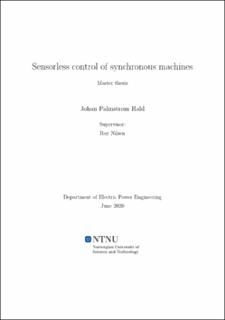| dc.contributor.advisor | Nilsen, Roy | |
| dc.contributor.author | Hald, Johan Palmstrøm | |
| dc.date.accessioned | 2021-09-15T17:15:28Z | |
| dc.date.available | 2021-09-15T17:15:28Z | |
| dc.date.issued | 2020 | |
| dc.identifier | no.ntnu:inspera:54192396:20908382 | |
| dc.identifier.uri | https://hdl.handle.net/11250/2778232 | |
| dc.description.abstract | Med den drastiske økningen i utbytning av regulerbar kraftproduksjon til fordel for variable, fornybare energikilder som vind- og solkraft i fastlands Europa, er etterspørselen etter fleksibilitet i kraftnettet stadig økende. Med denne økende etterspørselen følger et stadig større press på det norske nettet, ettersom Norges velutviklede vannkraftressurser er en høyt etterspurt handelsvare. En måte å dekke denne etterspørselen på er koblingen av justerbar hastighetsdrift (ASH) synkronmaskiner og pumpekraftverk.
Effektiv kobling mellom pumpekraft og ASH synkronmaskiner avhenger av et robust kontrollsystem. Det fremste innen kontroll av elektriske maskiner som har kommet fram over de siste tiårene er sensorløs kontroll, hvor posisjonen og farten til rotoren blir estimert heller enn målt. Sensorløs kontroll lover en høyere pålitelighet og robusthet, i tillegg til reduserte kostnader og systemkompleksitet.
I denne masteroppgaven, som er en videreutvikling av spesialiseringsprosjektet utført høsten 2019, presenteres en metode for sensorløs kontroll av en separat eksitert synkronmaskin med dempeviklinger, som baserer seg på å bruke ekstra eksitasjonssignaler i feltstrømmen for å estimere rotorposisjonen, kalt "self-sensing"-metoden. Metoden har blitt kombinert med allerede etablerte estimeringsmetoder basert på motindusert spenning, kalt strøm- og spenningsmodellen. Grunnet mangel av motindusert spenningsinformasjon ved stillstand og lave motorhastigheter har verken strøm- og spenningsmodellen nok tilgjengelig data for å nøyaktig estimere rotorposisjonen.
Gjennom en omfattende analyse og undersøkelse ved bruken av de ekstra eksitasjonssignalene i feltstrømmen for posisjonsestimering og flere fase-låste løkker (PLL), har det blitt vist at modellen har drastisk redusert feilen i estimater ved stillstand og lave rotorhastigheter under momentkontroll.
Implementering av "self-sensing"-metoden ved fartskontrollert drift har vist samme forbedring. Den overordnede kontrollstrukturens evne til å opprettholde moment ved stillstand og null-fartkrysninger har økt, mens strøm- og spenningsmodellen har resultert i systemkollaps ved sammeligningstester. | |
| dc.description.abstract | As the European continent is seeing a rapid dismantling of dispatchable power generation, for intermittent renewable energy sources such as wind and solar power, the need for flexibility in the continent's electrical grid is ever increasing. With this increased demand comes increased pressure on the Norwegian grid, as Norway's well-developed suite of hydropower installations is a highly sought after commodity. However, the continent's demand for flexibility far outstretches the available Norwegian resources. One way to cover this demand is the synergy of adjustable speed hydro (ASH) synchronous machines and pumped hydro.
For the combination of pumped hydro and ASH synchronous machines to work efficiently there is a need for a robust control system. The cutting-edge in control of electrical machines over the last decades has been sensorless control, wherein the position and speed of the rotor are estimated rather than measured. Offering higher reliability and robustness, in addition to lower costs and reduced system complexity, the future of electrical motordrives is sensorless control.
In this Master thesis, which is a continuation of the specialization project done in the fall semester of 2019, a novel approach of sensorless control of a separately excited synchronous machine with damper windings is presented. The methodology utilizes additional excitation signals in the field current to detect the rotor position, in what is called the self-sensing method. The method has been combined with the already established estimation methods based on the generation of back-EMF, called the current and voltage model. Due to a lack of back-EMF information at standstill and low-speed operation, both the current and voltage model has insufficient available data to estimate the rotor position at standstill and low-speed operation accurately.
Through an extensive investigation and analysis of the self-sensing method and various phase-locked loops combinations (PLL), it was shown that the model, being solely reliant on the additional field excitation signals and its response on the stator currents, drastically reduced the error at zero-crossing and low-speed for torque-controlled operation. While the gains achieved for torque-controlled operation is dependent on the acceleration of the rotor through zero-crossing, due to inherent limits in the PLL structure, the self-sensing model has been unequivocally shown to improve the sensorless control for standstill and low-speed operation.
The same improvements have been proven under speed-controlled operation where the introduction of the self-sensing model has shown a drastic increase in the sensorless control structure's ability to hold torques through zero-hold and -crossings, where comparative testing running only the current and voltage model showed complete system collapse. | |
| dc.language | | |
| dc.publisher | NTNU | |
| dc.title | Senorless control of synchronous machines | |
| dc.type | Master thesis | |
